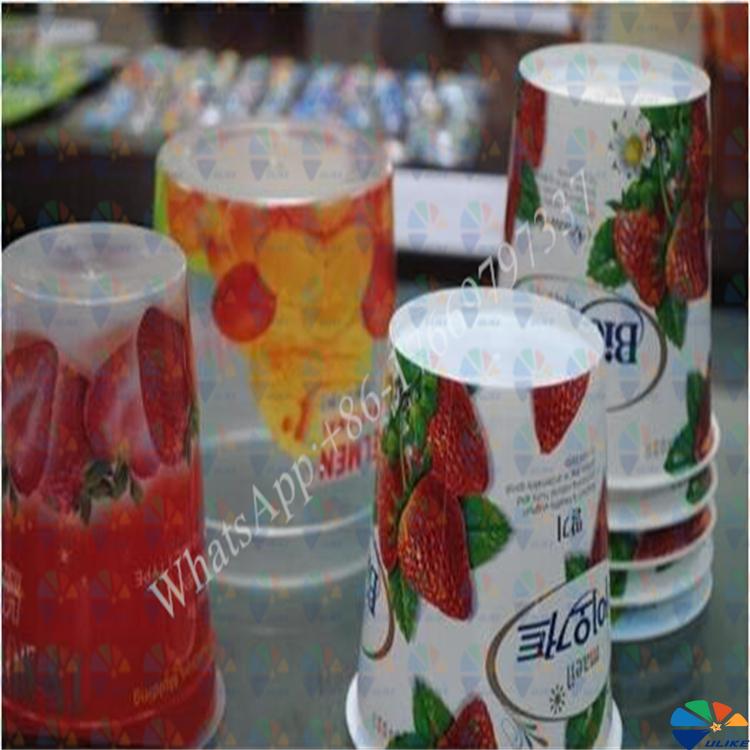Concept of IML
1-
Concept of IML
IML is a kind of thermal transfer film. It places the prepared film on the specified position of the substrate and forms a layer of exquisite patterns on the surface of the product through the heat and pressure of the blow molding equipment.
IML plate effect diagram
2-
Features of IML
1. IML can be used in daily necessities, daily chemical manufacturing products, food packaging and medicine bottle packaging industries, some decorative products with special shapes, such as some rounded corners and round plastic products, especially plates, dishes, toy darts, etc.
2. IML can be used in hollow blow molding products, because these blow molding products are relatively brittle and have poor heat resistance, and cannot withstand the high temperature and pressure of the heat transfer machine.
If IML is used, it can be directly printed on the surface without relying on the heat transfer machine, which is one of its highlights.
3-Simple operation steps of
in-mold labeling
1. First, cut the blank base film according to the customer's requirements
2. Apply ink on the blank base film to form a beautiful pattern
3. Apply the corresponding glue and evaporate it
4. Re-inspect the quality to ensure product quality
5. Cut the re-inspected in-mold film into corresponding specifications
6. Die-cut and punch the in-mold film that has been slit
7. Electrostatic treatment and proper packaging
4-Matters to be noted during the production of in-mold labeling
A. Thickness
When designing the in-mold label on the surface of the container, the shape of the trademark needs to be determined according to the contour of the container to be filmed. The thickness of the label is approximately between 180 and 220μm.
B. Machine tension
The requirements of in-mold labeling for paper feeding and tension control are mainly centered on reducing the deformation of the flower film material. The printing machine should be equipped with a material tension automatic control device to make the material tension uniform during the paper feeding process to ensure accurate label overprinting.
c. Corona treatment
In order to ensure high-quality printing, the in-mold label is generally subjected to corona treatment. When the surface tension of the label material is greater than 40x10-5N, corona treatment can be omitted, because corona treatment has negative effects after all, and will generate a large amount of static electricity on the surface, making it difficult to peel off the label.
![af]() Afrikaans
Afrikaans![sq]() Albanian
Albanian![am]() Amharic
Amharic![ar]() Arabic
Arabic![fr]() French
French![es]() Spanish
Spanish![ru]() Russian
Russian![de]() German
German![hy]() Armenian
Armenian![it]() Italian
Italian![ja]() Japanese
Japanese![ko]() Korean
Korean![pt]() Portuguese
Portuguese![hi]() Hindi
Hindi![az]() Azerbaijani
Azerbaijani![ro]() Romanian
Romanian![pl]() Polish
Polish![th]() Thai
Thai![el]() Greek
Greek![eu]() Basque
Basque![en]() English
English![zh-CN]() Chinese (Simplified)
Chinese (Simplified)![zh-TW]() Chinese (Traditional)
Chinese (Traditional)![be]() Belarusian
Belarusian![bn]() Bengali
Bengali![bs]() Bosnian
Bosnian![bg]() Bulgarian
Bulgarian![ca]() Catalan
Catalan![ceb]() Cebuano
Cebuano![ny]() Chichewa
Chichewa![co]() Corsican
Corsican![hr]() Croatian
Croatian![cs]() Czech
Czech![da]() Danish
Danish![nl]() Dutch
Dutch![eo]() Esperanto
Esperanto![et]() Estonian
Estonian![tl]() Filipino
Filipino![fi]() Finnish
Finnish![fy]() Frisian
Frisian![gl]() Galician
Galician![ka]() Georgian
Georgian![gu]() Gujarati
Gujarati![ht]() Haitian Creole
Haitian Creole![ha]() Hausa
Hausa![haw]() Hawaiian
Hawaiian![iw]() Hebrew
Hebrew![hmn]() Hmong
Hmong![hu]() Hungarian
Hungarian![is]() Icelandic
Icelandic![ig]() Igbo
Igbo![id]() Indonesian
Indonesian![ga]() Irish
Irish![jw]() Javanese
Javanese![kn]() Kannada
Kannada![kk]() Kazakh
Kazakh![km]() Khmer
Khmer![ku]() Kurdish (Kurmanji)
Kurdish (Kurmanji)![ky]() Kyrgyz
Kyrgyz![lo]() Lao
Lao![la]() Latin
Latin![lv]() Latvian
Latvian![lt]() Lithuanian
Lithuanian![lb]() Luxembourgish
Luxembourgish![mk]() Macedonian
Macedonian![mg]() Malagasy
Malagasy![ms]() Malay
Malay![ml]() Malayalam
Malayalam![mt]() Maltese
Maltese![mi]() Maori
Maori![mr]() Marathi
Marathi![mn]() Mongolian
Mongolian![my]() Myanmar (Burmese)
Myanmar (Burmese)![ne]() Nepali
Nepali![no]() Norwegian
Norwegian![ps]() Pashto
Pashto![fa]() Persian
Persian![pa]() Punjabi
Punjabi![sm]() Samoan
Samoan![gd]() Scottish Gaelic
Scottish Gaelic![sr]() Serbian
Serbian![st]() Sesotho
Sesotho![sn]() Shona
Shona![sd]() Sindhi
Sindhi![si]() Sinhala
Sinhala![sk]() Slovak
Slovak![sl]() Slovenian
Slovenian![so]() Somali
Somali![su]() Sudanese
Sudanese![sw]() Swahili
Swahili![sv]() Swedish
Swedish![tg]() Tajik
Tajik![ta]() Tamil
Tamil![te]() Telugu
Telugu![tr]() Turkish
Turkish![uk]() Ukrainian
Ukrainian![ur]() Urdu
Urdu![uz]() Uzbek
Uzbek![vi]() Vietnamese
Vietnamese![cy]() Welsh
Welsh![xh]() Xhosa
Xhosa![yi]() Yiddish
Yiddish![yo]() Yoruba
Yoruba![zu]() Zulu
Zulu


